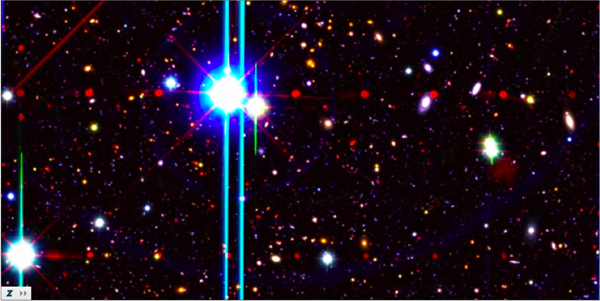Astrophysicists have released images of the largest swath of the deep universe ever observed. The images gaze 13 billion years back in time and cover an area of the sky four times the size of the full moon.
Omar Almaini, at the University of Nottingham, and colleagues netted infrared observations of 250,000 galaxies, the earliest less than a billion years after the Big Bang. The farther away from Earth you look in the universe, the farther back in time you see.
“No one has been this deep over such a large area of sky,” says Almaini. The ongoing UltraVISTA project will look slightly less deep in time and over a larger area of the sky, Almaini says. The Hubble Deep Field has observed deeper in time, as long ago as 400 million years after the Big Bang, but over a much smaller area.
The data come from more than 1,000 hours of observation over eight years, beginning in 2005, at the UK Infrared Telescope on the summit of Mauna Kea, Hawai’i. The team revealed their results at the National Astronomy Meeting in Nottingham.
“Now,” says Almaini, “the fun begins. Now we’re going to use these data to understand the formation and evolution of galaxies.”
Their uniquely large data set has several advantages. For one, 250,000 galaxies’ worth of data gives them a lot of statistical power. Secondly, it gives them a better chance of finding rare objects, like galaxies in transition.
“One of the big puzzles in astrophysics is why locally the most massive elliptical galaxies are red, and dead, and no longer forming stars,” says Almaini. “Why did the most massive galaxies switch off their star formation early in the universe, it looks like around 10 billion years ago?” How galaxies made this transition is also a mystery.
Almaini’s team has developed a technique to identify these “post-starburst” galaxies, as he calls them. “These are very rare, but with our new data we should be able to find many hundreds, if not thousands, of these transition objects and then hopefully solve this puzzle.”
“There are ideas now that maybe supermassive black holes terminate star formation,” Almaini says. “That’s one of the things we’d like to test.”
They’ll also be looking for quasars and dark matter. The latter is invisible, but Almaini says that they can get at the underlying dark matter distribution by observing how galaxies cluster across a large enough area of space.
Finally, at the far limit of this data set’s time-traveling abilities, astrophysicists may be able to observe the most massive galaxies just after the Epoch of Reionization. During this mysterious period (ending a billion years after the Big Bang), the hydrogen of the universe became charged instead of neutral, and this charge is what allows light from early quasars, stars, and galaxies to travel through the universe and reach us.










